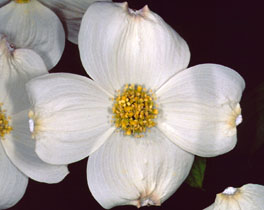Our lab is working on perianth evolution and several topics on plant molecular evolution. We are interested in the mechanisms of the transference of function in plants, especially for the petal formation. Below are the main topics that have been conducted in my lab.
(1) Evolutionary development of perianthsWe are interested in the transference of function in floral organs, and the putative mechanism behind this phenomenon. In particular, we are interested in the molecular developmental study of petaloid structure in plants. The rationale is based on the study in Arabidopsis that the ectopic expression of petal identity genes in Arabidopsis has shown to be sufficient turning sepals or leaves into petal-like structures. However, we only find weak expression of some, but not all, of the identified ABE-class genes in the showy bracts of dogwoods (Cornus florida). In contrast, the expression patterns are abnormal in calycophylls of Mussaenda pubescens, that most of them are ubiquitously expressed. The results suggest different mechanisms existed for controlling the petaloid structure in various plants. This work is still ongoing and several other approaches have been employed to elucidate the mechanism of petaloid formation. We are also interested in the evolution of floral organ identity genes among basal core-eudicots, including Trochodendrales, Santalales, Saxifragaceae (s.s.), and Ranunculales. These plants show vast variations in floral structure and are keys to elucidate the perianth evolution in eudicots. We are examining gene duplication events of floral organ identity genes among these lineages, as well as the expression patterns of these genes. Related published work can be seen in Kramer et al. (2006) and Wu et al. (2007). |
|||||||
 |
|||||||
 |
(2) Molecular evolution and codon usage analysisWe use phylogenetic analysis for systematics and also multivariate analysis of codon usage and amino acid usage to examine the gene/species evolution. One of the analysis on the frameshift mutation in MADS-box genes has been published in BMC Evolutionary Biology (Kramer et al. 2006). Another project is on the genome evolution in banana bunchy top virus (BBTV), in collaboration with Dr. H.H. Yeh at the Department of Plant Pathology and Microbiology, NTU. Some of the results using these analyses has been published in Journal of Virology (Hu et al. 2007). We have selected several non-photosynthetic plants, either parasitic or saprophytic, to examine presence of plastid genome, including Balanophora, Mitrastema, Cheilotheca, and etc. Currently we used Mitrastema as our model to examine the presence of plastid genes. We are also interested to know if they still harbor other photosystem related genes in their nuclear genome. |
||||||
(3) Plant reproductive biologyA. Sex in plants Although most flowering plants are bisexual, there are many examples of unisexual flowers found in various groups of plants. Among them, dioecious plants are around 4-6%. Why do plants want to be separated in male and female? How does dioecy maintained? Bawa also found an interesting phenomenon, that is the proportion of dioecious species is much higher in tropical islands than other regions. Our lab has done some survey for the flora of Taiwan and we welcome anyone who is interested in this topic join our group! B. Pollination biology We are working on the pollination biology of Symplocos wikstroemiifolia (Symplocaceae), Terstroemia gymnanthera (Pentaphylaceae), and Rubus spp. (Rosaceae). The former two have been documented as androdioecious species. |
|||||||
(4) Phylogenetic systematicsFor phylogenetic systematics studies. We are working on the phylogenies of Balanophoraceae, Clematis (Ranunculaceae), Rubus (Rosaceae), Bulbophyllum (Orchidaceae) and members of the tribe Millettieae (Fabaceae). Here is the link to the website I created for Millettieae when I was a graduate student, the materials are not updated well, but feel free to browse around. Some recent systematic work published from my lab can be seen: Chuang & Hu (2004), Hu & Chang (2003), and Wu et al. (2007). |
|||||||
References
Chuang, S.-L. and Hu, J.-M.* 2004. The evolution of chloroplast matK genes, including identification of new homologues from Ophioglossum petiolatum and two lycophytes. Taiwania 49(4): 273-291.
Hu, J.-M.* and Chang S.-P. 2003. Two new members of the Callerya group (Fabaceae) based on phylogenetic analysis of rbcL sequences: Endosamara racemosa (Roxb.) Geesink and Callerya vasta (Kosterm.) Schot. Taiwania 48(2): 118-128.
Hu, J.-M.*, H.-C. Fu, C.-H. Lin, H.-J. Su, and H.-H. Yeh. 2007. Reassortment and concerted evolution in banana bunchy top virus genome. Journal of Virology 81: 1746-1761.
Kramer, E. M.*, H.-J. Su, C.-C. Wu, and J.-M. Hu. 2006. A simplified explanation for the frameshift mutation that created a novel C-terminal motif in the APETALA3 gene lineage. BMC Evolutionary Biology 6: 30.
Wu, H.-C., H.-J. Su, and J.-M. Hu*. 2007. The identification of A-, B-, C-, and E-class MADS-box genes and implications for perianth evolution in the basal eudicot Trochodendron aralioides (Trochodendraceae). International Journal of Plant Sciences 168:775-799.
[EMAIL: jmhu@ntu.edu.tw]